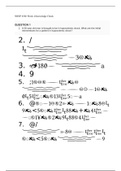Resume
Summary CHAPTER 1+2 HISTORY OF THE MUSLIM WORLD TO 1750 BY EGGER
- Cours
- Établissement
- Book
Samenvatting hoofdstuk 1 + 2 HISTORY OF THE MUSLIM WORLD TO 1750 BY VERNON O. EGGER. NB: 'M' is often used as short for Prophet Mohammed in this document.
[Montrer plus]













